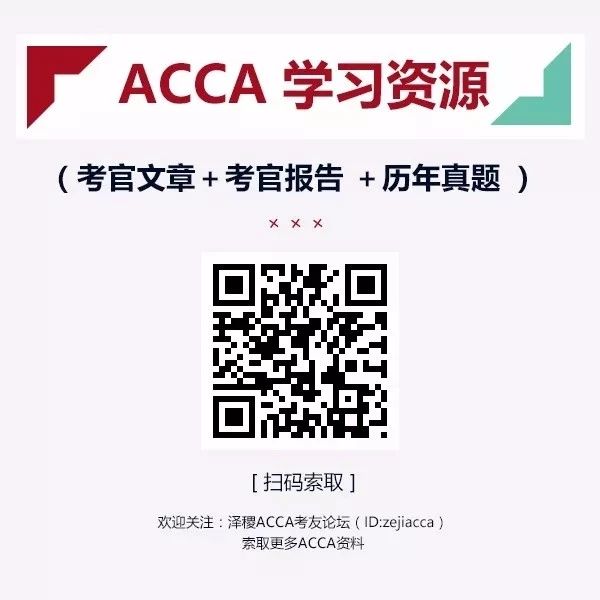干货分享|ACCA F9 2018 考官报告 例题解析
作者:泽稷编辑 发布时间:2018-04-28 11:00
Section A
Example 1
Leah Co is an allequity financed company which wishes to appraise a project in a new area of activity.Its existing equity beta is 1.2.The industry average equity beta for the newbusiness area is 2.0,with an average debt/debt+equity ratio of 25%.Therisk-free rate of return is 5%and the market risk premium is 4%。
Ignoring tax andusing the capital asset pricing model,calculate a suitable risk-adjusted costof equity for the new project。
答案:
这道题考察的知识点是risk-adjustedcost of equity
这道题中,考生应该直接忽略leah公司的equity beta,因为leah公司现在要进入一个新行业,business risk发生了变化,应该使用new business的行业平均asset beta,题目中给出了行业平均equity beta 2.0,又给出了equity的debt比例,那么asset beta(βa)=2 x(75/100)=1.5。
Asset beta是反映新的business risk,现在再来考虑到leah的financial risk,因为leah Co只使用了权益资金,没有使用debt资金,所以βa=βe
使用CAPM,ke=5+1.5 x 4=8.96%=11%
这道题主要考察了,risk-adjustedcost of equity的计算,βa和βe的区别和计算。
Example 2
Alpha Co and BetaCo are two companies in different industries who are both evaluating the acquisitionof the same target company called Gamma Co.
Gamma Co is in thesame industry as Alpha Co.
Alpha Co hasvalued Gamma Co at$100m but Beta Co has only valued Gamma Co at$90m.
Which of followingstatements would explain why Alpha Co's value of Gamma Co is higher?
A:Alpha Co has used more prudent growth estimates
B:Beta Co could achieve more synergy
C:Beta Co is a better negotiator than Alpha Co
D:Gamma Co is a direct competitor of Alpha Co
答案:D
A选项:Alpha Co在对Gamma Co进行估值时,对于Gamma co未来的增长率的估计是比较谨慎的。
但题干中很明显,a公司的$100m比B公司的$90m要多。显然B公司更谨慎。
B选项:合并之后,B公司可以获得更多的协同效应。这样的话,B公司的估值应该比较高。
C选项:谈判是在收购的最后阶段,现在是一开始的估值阶段,用不到谈判能力。
D选项:G公司是A公司的竞争对手,他们合并在一起可以获得更多的市场份额,产生更多的协同效应,所以A公司给出的估值比较高。
Section B
Section B是case-based选择题,考纲中的任何地方都可能出现。这次考到的内容如下:
Investmentappraisal
在计算投资评估问题时出现了一些典型的常见错误。例如,没有正确确认项目的相关现金流,或者弄错了未来现金流发生的时间点。希望考生以后能够认真地读题,避免这些错误。另外,有些考生不理解在资金有限的情况下,如何实现股东财富最大化,不是选择NPV最高的项目,还要考虑项目的投资额。对于考生来说,还有其他一些难点,包括在做lease or buy项目评估时,使用的折现率应该是costof debt。
Businessvaluation
常见的错误:
1、忽略了公司内部产生的goodwill
2、PE ratio相关计算:earing=税后利润-优先股股息。
Risk management
常见错误:
1不理解风管管理衍生品的特点,特别是利率期权。
2foreign exchange hedging计算中,使用不恰当的汇率。
3不理解利率波动的原因。
Financial management function
常见错误:
1不理解reduce stakeholder conflict的方法。
2不懂如果实现股东财富最大化。
Section C
Section C中最普遍的问题是:计算题比理论题答得好。尽管大多数考试都尝试回答理论问题,但是很多回答表明他们根本没有理解知识点。这些理论题分值高达10分,更有一部分考生根本没有尝试回答。
考试中一定要认真阅读题目要求,并且在答题过程中要时不时地回顾题目中的要求,确保没有漏掉的问题。如果题目要求calculate and comment,那么评价一定是建立在计算之上的,并且评价不能只写一两个单词。例如,如果计算出项目是positive NPV,评价的时候不能简单地说accept,必须要解释为什么接受。如果题目要求‘discuss whether......’something is important/relevant/beneficial,简单地列出一些观点是不够的,要有解释论证观点。
这次考试中SectionC主要考查的内容有:
Investmentappraisal techniques
Allowing forinflation and taxation in DCF(discounted cash flow)(可参考September/December 2017Q32 Pelta Co)
Adjustingfor risk and uncertainty in investment appraisal
Specificinvestment decisions
Sources ofand raising business finance
Estimatingthe cost of capital(可参考September/December 2017 Q31 Tufa)
Sources offinance and their relative costs
Capitalstructure theories and practical considerations
